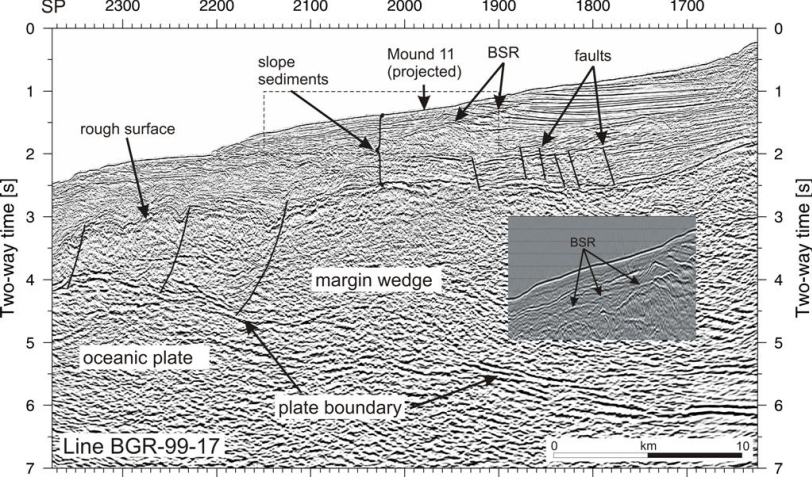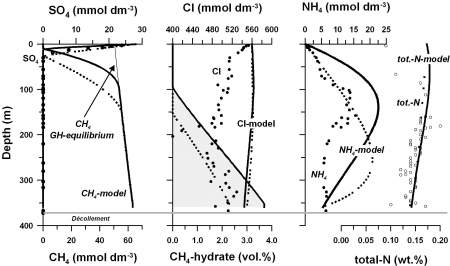 Web Content Anzeige Web Content Anzeige
Methane hydrate in sediments of the overriding plate, Costa Rica forearcShallow gas hydrate accumulation in mud volcanoes in the Costa Rica forearc was postulated before, but could be proven during SFB574 research activities. A gas hydrate bearing sediment core was recovered from surface sediments at the southwestern slope of the recently discovered Mound 11, a mud volcano located 30 km arcward from the trench, on the continental slope off Costa Rica at 1000 m water depth. The gas hydrate content of the sediment was up to 60 % and mainly consisted of methane hydrate. The ð13C (-45.2 to –43.3 ‰ PDB) and ðD (-125 to –143 ‰ SMOW) values of methane from sampled hydrates indicate a deep (thermogenic) source of fossil methane generated by degradation of organic matter within the subducted slab. Near surface faults and deeply cutting faults, identified in multichannel seismic reflection profiles provide pathways for fluid migration through the ~6 km thick margin wedge, into the ~1 km of overlying terrigenous sediments (Fig. 1). Mound 11 overlies a Bottom Simulating Reflection at 340 m bsf and transport of sediment and methane-rich fluids from greater depth through the gas hydrate stability zone is suggested.
Fig. 1: Time-migrated section of line BGR-99-17 across the middle slope showing the projected location of Mound 11, which is located at a distance of only 1 km from the seismic line. The slope sediments extend in depth to the rough surface, which marks the top of the margin wedge. A low-frequency landward dipping reflection marks the boundary to the subducting slab. A bottom simulating reflector delineates the bottom of the hydrate stability zone. Gas hydrates and Cl-depleted fluids in upper plate sediments off Costa Rica have also been recovered by ODP drilling (Leg 170; Kimura et al., 1997). The freshening of these fluids was previously regarded as an artifact caused by the dissociation of gas hydrates upon core retrieval (Kimura et al., 1997; Kopf et al., 2000). Hensen and Wallmann (2005) further explored the origin of chloride anomalies and quantified gas hydrate inventories by use of a one-dimensional reactive-transport model. Model calculations reveal that up to 4 vol.% (pore space) of gas hydrate may be formed by in-situ POC degradation at the base of sedimentary sequence, but this amount is much too small to account for the strong Cl-depletion observed in the ODP pore water samples (Fig. 2). Moreover, the simulations showed that moderate upward flow has a strong impact on the location of the upper limit of the modeled gas hydrate occurrence zone (GHOZ) and may increase the total amount of gas hydrate by more than 50%. Our best estimate of the amount of gas hydrate within the GHOZ is on average 1.65 vol.% of pore space, which corresponds to about 2.5 Tg of methane per km trench within the frontal prism of slope sediments.
Fig. 2: Model results from site 1040; ODP Leg 170 (Hensen and Wallmann, 2005). Dissolved CH4-concentrations are calculated from organic matter degradation rates, constrained by the TOC (total organic matter) profile at steady-state. At about 100-150 mbsf methane concentrations raise above equilibrium concentration with gas-hydrate and hydrate begins to form. Dotted (no upward flow) and solid (upward flow of 0.03 cm yr-1) lines indicate the effect of fluid flow on gas hydrate formation potential. Artificial destabilization of the gas hydrate due to depressurization and temperature increase upon core retrieval cannot explain the observed Cl-depletion because only 4 vol.% (pore space) of gas hydrate are produced via in-situ methanogenesis. References
Hensen C. and Wallmann K. (2005) Methane formation at Costa Rica continental margin - constraints for gas hydrate inventories and cross-décollement fluid flow. Earth Planet. Sci. Lett. 236, 41-60.
Kimura G., Silver E., Blum P. and cruise participants (1997) Proc. ODP, Init. Repts., 170. College Station, TX (Ocean Drilling Program).
Kopf A., Deyhle A., and Zuleger E. (2000) Evidence for deep fluid circulation and gas hydrate dissociation using boron and boron isotopes of pore fluids in forearc sediments from Costa Rica (ODP Leg 170). Marine Geology 167, 1-28. Schmidt M., Hensen C., Mörz T., C. Müller, Grevemeyer I., Wallmann K., Mau S., Kaul N. (2005) Methane hydrate accumulation in Mound 11 mud volcano, Costa Rica forearc. Marine Geology 216, 77-94 |
 Events Events
Kieler Wissenschaftler fühlen den 'Puls der Erde' Wie funktioniert die Recyclingmaschine der Erde?Nach elf Jahren endet der Kieler Sonderforschungsbereich 574 zu Subduktionszonen Final colloquium of SFB 574 Teilprojekt ÖffentlichkeitsarbeitMEERESFORSCHUNG FÜR MICH UND DICH |
|
©SFB574 // Wischhofstrasse 1-3 // D-24148 Kiel // T. +49 (0)431 600 1413 // elange [AT] geomar.de







